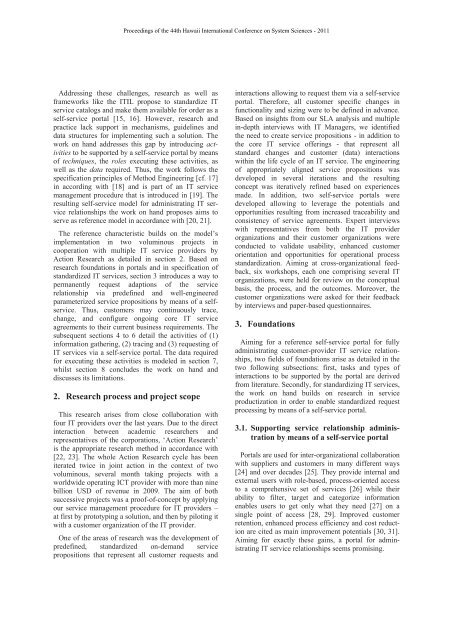Kundenorientierte Gestaltung und Vereinbarung standardisierter IT ...
Kundenorientierte Gestaltung und Vereinbarung standardisierter IT ...
Kundenorientierte Gestaltung und Vereinbarung standardisierter IT ...
Erfolgreiche ePaper selbst erstellen
Machen Sie aus Ihren PDF Publikationen ein blätterbares Flipbook mit unserer einzigartigen Google optimierten e-Paper Software.
Proceedings of the 44th Hawaii International Conference on System Sciences - 2011<br />
Addressing these challenges, research as well as<br />
frameworks like the <strong>IT</strong>IL propose to standardize <strong>IT</strong><br />
service catalogs and make them available for order as a<br />
self-service portal [15, 16]. However, research and<br />
practice lack support in mechanisms, guidelines and<br />
data structures for implementing such a solution. The<br />
work on hand addresses this gap by introducing activities<br />
to be supported by a self-service portal by means<br />
of techniques, the roles executing these activities, as<br />
well as the data required. Thus, the work follows the<br />
specification principles of Method Engineering [cf. 17]<br />
in according with [18] and is part of an <strong>IT</strong> service<br />
management procedure that is introduced in [19]. The<br />
resulting self-service model for administrating <strong>IT</strong> service<br />
relationships the work on hand proposes aims to<br />
serve as reference model in accordance with [20, 21].<br />
The reference characteristic builds on the model’s<br />
implementation in two voluminous projects in<br />
cooperation with multiple <strong>IT</strong> service providers by<br />
Action Research as detailed in section 2. Based on<br />
research fo<strong>und</strong>ations in portals and in specification of<br />
standardized <strong>IT</strong> services, section 3 introduces a way to<br />
permanently request adaptions of the service<br />
relationship via predefined and well-engineered<br />
parameterized service propositions by means of a selfservice.<br />
Thus, customers may continuously trace,<br />
change, and configure ongoing core <strong>IT</strong> service<br />
agreements to their current business requirements. The<br />
subsequent sections 4 to 6 detail the activities of (1)<br />
information gathering, (2) tracing and (3) requesting of<br />
<strong>IT</strong> services via a self-service portal. The data required<br />
for executing these activities is modeled in section 7,<br />
whilst section 8 concludes the work on hand and<br />
discusses its limitations.<br />
2. Research process and project scope<br />
This research arises from close collaboration with<br />
four <strong>IT</strong> providers over the last years. Due to the direct<br />
interaction between academic researchers and<br />
representatives of the corporations, ‘Action Research’<br />
is the appropriate research method in accordance with<br />
[22, 23]. The whole Action Research cycle has been<br />
iterated twice in joint action in the context of two<br />
voluminous, several month taking projects with a<br />
worldwide operating ICT provider with more than nine<br />
billion USD of revenue in 2009. The aim of both<br />
successive projects was a proof-of-concept by applying<br />
our service management procedure for <strong>IT</strong> providers –<br />
at first by prototyping a solution, and then by piloting it<br />
with a customer organization of the <strong>IT</strong> provider.<br />
One of the areas of research was the development of<br />
predefined, standardized on-demand service<br />
propositions that represent all customer requests and<br />
interactions allowing to request them via a self-service<br />
portal. Therefore, all customer specific changes in<br />
functionality and sizing were to be defined in advance.<br />
Based on insights from our SLA analysis and multiple<br />
in-depth interviews with <strong>IT</strong> Managers, we identified<br />
the need to create service propositions - in addition to<br />
the core <strong>IT</strong> service offerings - that represent all<br />
standard changes and customer (data) interactions<br />
within the life cycle of an <strong>IT</strong> service. The engineering<br />
of appropriately aligned service propositions was<br />
developed in several iterations and the resulting<br />
concept was iteratively refined based on experiences<br />
made. In addition, two self-service portals were<br />
developed allowing to leverage the potentials and<br />
opportunities resulting from increased traceability and<br />
consistency of service agreements. Expert interviews<br />
with representatives from both the <strong>IT</strong> provider<br />
organizations and their customer organizations were<br />
conducted to validate usability, enhanced customer<br />
orientation and opportunities for operational process<br />
standardization. Aiming at cross-organizational feedback,<br />
six workshops, each one comprising several <strong>IT</strong><br />
organizations, were held for review on the conceptual<br />
basis, the process, and the outcomes. Moreover, the<br />
customer organizations were asked for their feedback<br />
by interviews and paper-based questionnaires.<br />
3. Fo<strong>und</strong>ations<br />
Aiming for a reference self-service portal for fully<br />
administrating customer-provider <strong>IT</strong> service relationships,<br />
two fields of fo<strong>und</strong>ations arise as detailed in the<br />
two following subsections: first, tasks and types of<br />
interactions to be supported by the portal are derived<br />
from literature. Secondly, for standardizing <strong>IT</strong> services,<br />
the work on hand builds on research in service<br />
productization in order to enable standardized request<br />
processing by means of a self-service portal.<br />
3.1. Supporting service relationship administration<br />
by means of a self-service portal<br />
Portals are used for inter-organizational collaboration<br />
with suppliers and customers in many different ways<br />
[24] and over decades [25]. They provide internal and<br />
external users with role-based, process-oriented access<br />
to a comprehensive set of services [26] while their<br />
ability to filter, target and categorize information<br />
enables users to get only what they need [27] on a<br />
single point of access [28, 29]. Improved customer<br />
retention, enhanced process efficiency and cost reduction<br />
are cited as main improvement potentials [30, 31].<br />
Aiming for exactly these gains, a portal for administrating<br />
<strong>IT</strong> service relationships seems promising.

















